Home » Kitchen Improvement (Page 3)
Category Archives: Kitchen Improvement
SEN Design Expands Educational Access
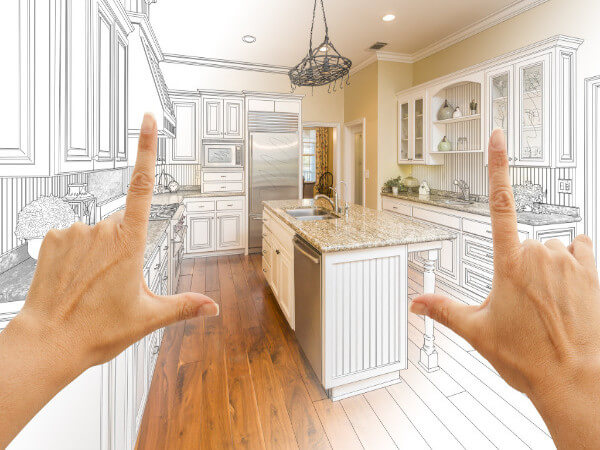
CHARLOTTE, NC — SEN Design Group, the Charlotte, NC-based kitchen and bath industry buying group and business education resource, has revamped its membership structure to increase access to business education opportunities for industry professionals, the organization announced.
“Under our previous structure, the majority of our educational opportunities were add-on expenses for our members, but we wanted to make sure our members had access to as much educational content as they wanted without added expense, so we have updated our membership structure to provide this much-needed resource at a minimal monthly investment,” said Catherine Daugherty, director of membership at SEN Design Group.
SEN Design Group will now offer three tiers of membership with differing benefits based on the member’s specific needs:
Associate Membership includes basic access to industry-specific business and sales education opportunities; this level is targeted for industry firms and independent designers who may not want to participate in a buying group or attend semi-annual conferences.
Signature U Membership includes increased access to industry-specific business and sales education opportunities, as well as access to SEN Design Group’s purchasing power and networking community.
Executive U Membership ($399 per month) includes everything in the Signature U Membership with additional benefits for industry leaders, such as dealer roundtables, a business development manual, personal profiling assessments for better hiring and communication, maximum quarterly rebates and more.
Additional details are available at www.sendesigngroup.com.
The post SEN Design Expands Educational Access appeared first on Kitchen & Bath Design News.
Did you miss our previous article…
https://www.thekawaiikitchen.com/?p=525
Designer Crafts Thoughtful Brand
Salisbury, NC — When Sara Lee started her design business in Salisbury, North Carolina, she knew just what to name it – SISU Home Designs. “SISU is personal to me,” says Lee. “It is a word used by my grandmother and mother of Finnish and Norwegian heritage. In one word, it embodies determination, potential, grit, freedom, courage, preparedness, strength, community and heart.” She adds, “In the business of design, there is inherent potential for what is possible.”
This inherent potential of design has, according to Lee, always been part of what drives her. “I always enjoyed setting up rooms and drawing house plans, even as a child,” she says. “Design school was a natural decision, and I specifically fell in love with kitchen and bath design. There is so much technicality, plus creativity. It’s problem-solving, communicating and wonderfully challenging.”
Branding a journey
Like most in the industry, Lee worked her way up from the bottom. “My first opportunity was with a large cabinet manufacturer, and I worked in marketing and sales, drawing plans for nationwide Lowe’s store displays and ‘The New American Home’ projects.” After a subsequent stint with a small dealer in order to gain more sales experience, she moved to Washington, DC to get a feel for the luxury market at a high-end showroom.
“A move to North Carolina in 2013 gave me new opportunities to serve a uniquely southern clientele,” she continues. “I thrived and felt a new confidence for what I could do for people and their spaces.”
When it came time to hang out her own shingle, Lee was careful to take her personal journey in the industry into account, working with an expert to create a cohesive narrative across all her digital channels.
“The branding [for SISU] was created by a lovely woman in London – we had much communication about who I am and what SISU represents,” she says. “The brand experience engages the senses and imagination through a visual narrative that is timeless, elegant and full of intentional detail – a visual identity that speaks with poetry and textural appeal to communicate inherent possibility and expertise.”
She adds, “Consistency is important. The brand carries over into social media and, I believe, sets a standard of credibility.” The Instagram presence of SISU in particular features a balance of crisp, beautifully staged project imagery, personal touches and anecdotes and graphics featuring the company’s sprouting plant-inspired logo.
New growth
Like the little sprout featured in SISU’s logo, Lee cultivates her client relationships carefully. “I get to know my clients through many meetings, calls and even texts,” she notes. “I have the privilege of going into people’s homes, and that requires trust, and I honor that. Our welcome packet actually goes over the entire process from beginning consultation to photoshoot day! It gives my clients a nice road map of what will happen over the course of the next few months.”
Looking ahead to the new year, Lee anticipates growth for her business. “Plans for 2022: I would love to hire some help and continue moving toward having a fantastic showroom.” 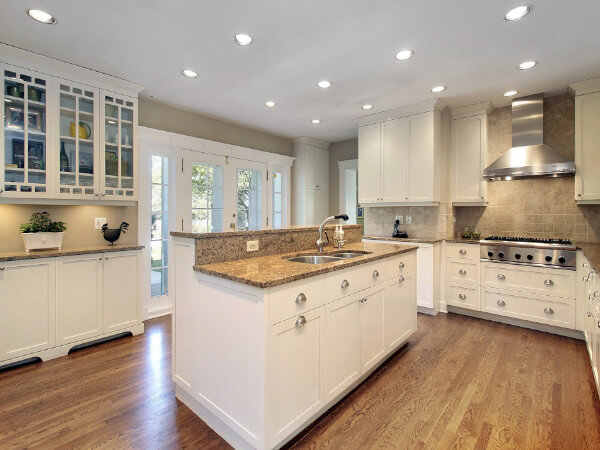
The post Designer Crafts Thoughtful Brand appeared first on Kitchen & Bath Design News.
Did you miss our previous article…
https://www.thekawaiikitchen.com/?p=519
Manufacturers Examine Supply Stresses
The DPH manufacturer concentrates on quality product and superior customer service. We are expected to provide both at competitive prices and with as little friction as possible, and I would say, most of us do. However, as we’ve witnessed the ‘Amazoning’ of the marketplace, amplified by a pandemic world, DPH manufacturers are fighting to maintain stability between logical expectations and ‘the Amazon effect.’ While we all appreciate the convenience of an Amazon marketplace, not all products can be treated equally. Unlike some other industries, hardware, plumbing, appliances and lighting often have specific shipping, installation and service needs.
Manufacturers are often viewed simply as marketers and salespeople, but as you may have seen when visiting a factory, manufacturing is a multi-faceted and complex business. Manufacturers in the U.S. and around the world are more tightly bound together through raw materials, labor and freight than may appear from a finished product.
TIES THAT BIND
Raw Materials: These are tied to industries as varied as oil and microchips. Most can be, and are, sourced nationally, but some must be sourced internationally. The flow of these products is regulated by countries, politics and commerce vagaries all around the world. In a normal year, price increases are expected and applied where necessary. In a COVID year, price increases have been compounded by national and worldwide slowdowns in supply, and increases are reflecting the upheaval.
Ben Alliker of HamatUSA explains, “2020 was not kind to many parts of the construction industry, mainly due to increased demand and decreased supply. Appliances and lumber both faced an initial crunch, and appliances remain on short supply and long lead times. For many DPH manufacturers, it was a mixed bag. Kitchen products, unlike a shower valve or new freestanding tub filler, don’t require an extensive remodel project. It’s relatively easy to install a new kitchen sink and faucet into an existing kitchen. Because of a huge number of people staying home across the world, and the relative ease of installation, HamatUSA saw a huge spike in demand over the summer and into the fall for kitchen sinks and faucets – both in the U.S. and in foreign markets.”
Production and Inventory: For manufacturers, this is handled in a wide variety of ways. That is to say some manufacturers work on a made-to-order, just-in-time basis with very little inventory, while others continually produce and maintain large inventories. There are pros and cons to both, but both take deft skills to balance output with demand and costs with profit.
Freight Costs: Costs associated with shipping have skyrocketed. The freight industry has been working throughout the pandemic, putting themselves at risk, but also realizing their undeniable necessity to the buying public. Their charges are reflecting their increased importance. ‘Fuel surcharges’ have become more common. Most DPH manufacturers have decided to keep freight rates as stable as possible, absorb many increases and/or set free freight levels.
LABOR AND SERVICE
Returns and Restocks: There is no easy fix for returns and restocks, which have become a flash point. We know, stuff happens. We all want to make these transactions as painless as possible. However, returns in our segment are not as easy as logging on and printing off a return label or simply scanning a QR code. Returns and restocks are expensive for everyone and cannot be ‘solved’ by simply raising prices to try and speed up the process. The customer changed their mind? It happens. But a faucet, toilet, steam unit, drain or tub cannot simply be Rambo-taped back into its packaging and dropped off. Return transport, reception and inspection, repair (if necessary), repacking (if possible) and return to inventory are only a few of the things that need to happen to a return. But, let’s be honest. We all know that a consumer wants a new product, so reselling product is difficult and frowned upon. What can be done with returned goods in our industry? How many ways are there to reduce, reuse, recycle? Manufacturers are often caught in a difficult position to satisfy consumers even when issues are not manufacturing related.
“Absorbing the costs associated with returns would most likely come with a price increase,” says Barbara Kratus of Infinity Drain. “Ultimately, it’s the consumer who will pay for it in the end, whether it’s Prime delivery or no-questions-asked returns – just as they do now on Amazon or any other online retailer where it’s baked into the price.”
Harris Wattles of Amba Products adds, “Re-stock fees are put into place for a variety of reasons, and a price increase simply to help offset a reduction/elimination of restock fees is not the answer to the problem. Increasing our prices for this reason will only make it harder to compete with other brands, especially the low-cost companies that you frequently see on Amazon, further eroding a company’s image while likely pricing our products out of the market.”
Labor Costs: In manufacturing, these are more competitive than ever. Recruiting, hiring and retaining the best people at every position is not exclusively difficult to showrooms or agencies. Most jobs in DPH manufacturing are not on assembly lines, but rather require trade training or artistic skill.
“Production facilities (during COVID) had less time/resources available for new product production. As responsible suppliers, we had to initiate protocols to keep production teams safe and healthy,” Alliker explains. “That universally meant less people in the factory at one time, and different production schedules, and thus decreased production capacity. We have seen COVID-related delays to the supply chain for new components as they also deal with COVID realities.”
Service: This is the other main component to successful manufacturing. We all remember bad service when we encounter it, and good service doesn’t always get recognized but is expected at all levels. Good service can be a simple smiling voice or a clear instruction about how to turn something on and off. Good service to a consumer can be slowly walking through how to operate a control, or good service can become bad service by not changing out that same control, that is working properly, because the user doesn’t like how the control operates. There is a fine line between the customer always being right and easy, on-site solutions.
Labor Costs: These are now jungle competitive in the field. Skilled tradespeople have never been as busy as they are now. Product support for warranty issues or installation inspections is a critical component in the overall experience of a product offering. Your warranty can be 100 years, but if you can’t get a professional to a job site, it’s not worth much. And we are all dependent upon how professional and experienced the tradesperson working with us can be during the initial installation or follow up servicing.
“I think products that incorporate tech could inspire young people to enter the trades,” says Kratus. “There are incredible innovations in building materials! We have to tout that at all levels of the building process.”
Patrick Weidl of ThermaSol adds, “ThermaSol, like many of us, is reliant on two trades – plumbers and electricians – to install the products. Have their expectations changed? Yes, absolutely. To meet those expectations, we introduced virtual trainings as it relates to product knowledge, installation and general 101s.”
The web runs the world. It would be an understatement to say that the web has gotten us through a lot this past year and we have all learned new angles to using it. It has become indispensable to our everyday lives. You can order a car, a boat, a diamond necklace, your groceries, birdfeed, a towel bar or a potty, all from the phone in your hand.
But as we all know, the web is a catch-22 for everyone selling product, any product, around the world. Amazon and similar companies ruled the web pre-COVID but now all companies have improved their online presence either as a seller or simply as a store window showing off their skills and products. Today, if your store front isn’t well represented on the web, your brick and mortar isn’t going to get the attention it deserves. We’ve all become accustomed to checking out a product or business on the web before we head out to see it. A web search can be simply to see what kind of COVID protocols are in place or to actually see if the product you want is on display or to read reviews of that product or business.
Web views and reviews are, without a doubt, a crucial component to the future of business. We’ve seen how reviews shape the perception of a product or company and how reviewers, paid and unpaid, can affect mom and pop start-ups, large corporations and government agencies, to name a few. The world watches and reads what everyone has to say about a product whether what is being said is true or valuable. They can literally make or break a business. So, we ask, should we raise our prices to be more ‘Amazon-like’?
It’s been a challenging time for all, but the future of construction and renovation is bright, and we are hopeful. 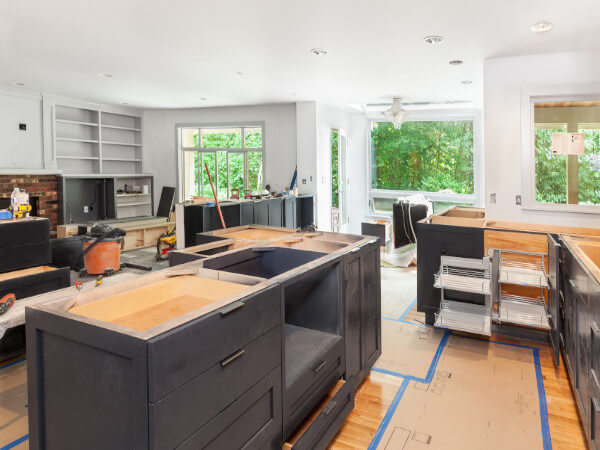
Kimberly Frechette is the national sales manager at Americh Corporation. She has worked in manufacturing, distribution and sales in the bathroom segment for 30 years. Frechette has been involved with DPHA for 18 years and is a returning Board member.
The post Manufacturers Examine Supply Stresses appeared first on Kitchen & Bath Design News.
Lingering Supply Chain Disruptions Seen as Only Transitory
WASHINGTON, DC — Supply chain disruptions continue to wreak havoc on material prices, product backlogs, freight costs and kitchen/bath project timelines, although current conditions are likely a temporary speed bump rather than a lasting roadblock to future market growth.
That’s the view of most construction market experts, including leading manufacturers, who are forecasting that the current challenges impacting the kitchen and bath product supply chain are transitory rather than permanent, and should dissipate, for the most part, by the same time next year.
Product suppliers – as well as kitchen/bath designers, distributors, home builders, remodelers and others – have been facing a year-long “perfect storm” of surging demand coupled with materials shortages, logistical challenges and global factory shutdowns wrought by the COVID-19 pandemic. Specifically, while remodeling demand is soaring as vaccination rates increase and emerging lifestyles spark reconfigured home layouts, supply-chain disruptions have resulted in acute shortages of critical building products. Supply constraints, at the same time, have caused material costs to soar.
According to the National Association of Home Builders, materials shortages are currently more widespread than at any time since the 1990s, while higher costs coupled with shortages have seen builder confidence in the market decline to its lowest level in a year.
Some 90% of surveyed home builders reported a shortage of plywood, and nearly as many a shortage of windows and doors, according to a recent NAHB survey, which also found that the situation has deteriorated “drastically” since the same time last year. Shortages were also seen impacting a broader-than-ever range of products, including appliances, tile and cabinets, as well as plastic, stainless steel, semiconductors and other components essential to the manufacturing of refrigerators, ovens, dishwashers, microwaves, washers and dryers.
According to the latest Kitchen & Bath Market Index (KBMI), compiled by the National Kitchen & Bath Association and John Burns Real Estate Consulting, supply constraints coupled with rising materials prices and shipping costs are forcing a growing number of kitchen/bath design firms to cope with longer lead times, seek alternative supply sources and increase their prices in an effort to preserve profit margins.
Some 45% of surveyed dealers and designers reported that material shortages and product pricing are affecting project timelines, according to the Q1 2021 KBMI. 60% of surveyed manufacturing firms reported average lead times of six-plus weeks, a significant increase from the previous quarter. 78% of those same manufacturers reported severe capacity constraints – also up from the previous quarter – due to extended lead times on raw materials and significant freight delays. At the same time, 67% of surveyed building and construction firms reported a backlog of three-plus months, with 21% reporting a backlog extending all the way through 2021.
According to Christofer von Nagel, CEO of BSH Home Appliances, the company’s brands – Bosch, Thermador and Gaggenau – “are facing unprecedented consumer demand coupled with global materials shortages and logistical issues that are impacting the supply chain.”
Those factors have caused longer-than-usual delays in delivering appliances (and have made it) “challenging to keep pace with continued high demand,” von Nagel said, adding that fulfillment for some products has recently been four to six months.
“The supply chain is fragile worldwide,” Von Nagel observed. “There are delays no matter where a product is manufactured (and) we expect conditions to be challenging for the foreseeable future.”
“We know this is frustrating for consumers,” Von Nagel added, noting that BSH has hired additional employees, increased production, and constantly monitored and adjusted its supply chain and manufacturing processes.
A growing number of other suppliers have done the same.
For example, in June, Delta Faucet Co. announced a decision to “prioritize production” for certain product brands or finishes, while temporarily pausing production for other collections and finishes. The pause is expected to be in effect until the fourth quarter of 2021, the company said, noting that while it won’t accept new orders during this time, it will fulfill existing orders.
“We estimate that market demand will begin to normalize during the second half of 2021, assuming that consumer spending patterns start to normalize by mid-year,” Electrolux CEO Jonas Samuelson recently told corporate shareholders, adding that capacity and electronic components availability will remain constraining factors into the second half of 2021.
“Because we recognize the situation is not going to change anytime soon, we’re working to be more proactive in alerting our customers to the delays so they can better plan,” Samuelson said. “By this time next year, we anticipate this situation will begin to balance across both demand and the shortages in materials and components needed to assemble the products.”
The post Lingering Supply Chain Disruptions Seen as Only Transitory appeared first on Kitchen & Bath Design News.
Did you miss our previous article…
https://www.thekawaiikitchen.com/?p=510
Registration Opens for CEDIA In-Person Expo
ALPHARETTA, GA — CEDIA Expo, the platform where technology integrators, designers and construction professionals connect, learn and engage, runs September 1 to 3 at the Indiana Convention Center in Indianapolis, IN. The leading residential technology event brings over 10,000 home technology design and construction attendees together with 300+ exhibitors at one of the first 2021 in-person events supporting the technology sector.
“We’re all eager to connect again on a human level and get back to face-to-face events as we celebrate everything we value as a community together again,” said Emerald Group Vice President, CEDIA Expo & KBIS, Jason McGraw.
CEDIA Expo is committed to making both new and established attendees and exhibitors feel connected and engaged by creating fresh programming, show floor activations, education, and training events in a safe, comfortable environment, show organizers noted.
New exhibiting brands include Environmental Lights, a leader in LED lighting solutions; Hisense, a fast-growing consumer electronics and appliance manufacturer that offers cutting-edge televisions and home appliances, and Datum Project Processing, a new to the market and show exhibitor that is participating in the rebranded Launchpad (formerly Innovation Alley).
Crestron, one of the leading complete, engineered smart home systems companies, is also returning to the main show floor. “We have been thrown into this global experiment,” said Crestron Exec. V.P., Global Marketing Brad Hintze. “We’ve had to innovate as a company, but so have our customers and partners throughout this year. It’s been an amazing experience and we’re excited to be back at CEDIA Expo to share our newest innovations and insights.”
DataComm Electronics, an industry-recognized brand name and a leading manufacturer of home theater and HDMI accessories and data/telecom connectivity solutions, also joins CEDIA this year. “I’m looking forward to the in-person CEDIA event in Indianapolis this year,” said Cassidy Jones, president of DataComm Electronics. “We have some new concepts to introduce, and the products really shine when we can talk about and demo them face-to-face.” Jones continues, “It’ll be nice to catch up with the customers and other exhibitor friends we missed in 2020.”
For registration details, visit https://cediaexpo.com/attend/registration-pricing/
The post Registration Opens for CEDIA In-Person Expo appeared first on Kitchen & Bath Design News.
Oasis at Home
While the COVID-19 pandemic has brought about many unexpected results, the refocus on the home is among the most prominent. Spending so much time at home has sparked a resurgence in remodeling and “changing things up” that rivals the busiest of times.
The bath is a room that has garnered a great deal of attention from weary homeowners, who are craving an at-home oasis that rivals the finest spas. Similar colors, materials and finishes are being favored by people who are looking to remodel the bath, so that a favorite respite can be recreated at home.
Personalization, too, is key to the changes being seen in the bath. Having spent so much time at home, residents are craving spaces that reflect their own personal style. Thankfully, bath faucet manufacturers are answering the call for personalization in the bath.
Among the hottest trends in bath faucets right now are:
–While geometric shapes are still popular, they often sport softer, more sleek and smooth lines, with curves all the rage.
–With a nod toward wellness, hands-free and motion sensor faucets have made it into the bathroom, keeping germs at bay.
–Warm tones, especially muted golds, are in high demand.
–Options abound with regard to faucet handles and spout styles, allowing homeowners to customize their choices.
–Coordinating and matching finishes and styles has returned, and not just in the bath but throughout the home.
–Matte finishes, especially matte black, are in high demand right now, with black sometimes outselling the ever-popular chrome staple.
The post Oasis at Home appeared first on Kitchen & Bath Design News.
Did you miss our previous article…
https://www.thekawaiikitchen.com/?p=504
Waterstone Faucets to Host Design Contest
MURRIETA, CA — Waterstone Faucets, the Murrieta, CA-based plumbing products manufacturer, will host its inaugural design competition to recognize designers, builders and architects who feature the brand’s products in their residential projects, the company announced.
Entry is free and will be open through Nov. 30 to all Waterstone installation projects across the U.S. and Canada, the company said. Waterstone will choose four winners across four categories: best traditional kitchen design, best contemporary kitchen design, best mud room or laundry room space, and best bar or butler’s pantry space. Winners will receive a cash prize, a three-piece faucet suite from Waterstone and promotion across Waterstone’s marketing and sales platforms, according to the company.
“It’s always exciting to see how designers use our products to create inspiring spaces,” said Chris Kuran, Waterstone founder and president. “We’re looking forward to recognizing the immense innovation and creativity within the design community through our first Waterstone Design Contest.”
Information about entering the competition can be obtained by visiting waterstoneco.com.
The post Waterstone Faucets to Host Design Contest appeared first on Kitchen & Bath Design News.
Did you miss our previous article…
https://www.thekawaiikitchen.com/?p=500
2021 Best Kitchens $75,000–$150,000
The post 2021 Best Kitchens $75,000–$150,000 appeared first on Kitchen & Bath Design News.
Google’s Impact on Your Business
The successful digital marketing of your company is based on a seemingly endless list of criteria. I think of it as creating a flywheel, when all the spokes of the wheel are moving successfully in the right direction, and your business is firing on all cylinders. Your social media is getting great impressions, you have multiple funnels of leads coming in via phone calls and emails and your website is busy with visitors.
The marketing work behind the scenes that makes this happen is sometimes hard to articulate succinctly, as each component has its own complexities for success. Google is the champion of connecting businesses and customers, and has been for years. Customers search on items using keywords, and Google determines which websites show up in the results.
Google is now making the most comprehensive updates in its history, and business owners need to act to stay relevant, and improve their website placement.
Website Ranking Changes
You may have noticed your searches on Google are showing different results than in prior months. This is due to its June Core Update, which rolled out in June 2021 and rewards websites with quality content. Website content is graded for strong E-A-T – Expertise, Authoritativeness and Trustworthiness. Another overarching assessment is called Your Money Your Life (YMYL). Collectively, they rate the quality of the content and if the content can impact the life of the visitor positively. Core competencies websites should:
Contain quality content for your website visitors. Does your website contain written content that just scratches the surface of the subject matter on your website pages? Add content that educates and informs your visitors by delving deeper into the topic. This is good for brands that have products with unique and desirable features. For example, The Corian Endura website goes into details about the product Corian Endura. “It is highly UV resistant. Colors and patterns will not fade…It won’t burn or melt in temperatures up to 1000 degrees Fahrenheit, making it a smart choice for decorative fire surrounds.” This detailed explanation of a benefit is exactly what Google is encouraging.
Use related keywords that satisfy the intent of the visitor. It is not just about the search keyword, but why that keyword was chosen. A good example is the keyword “DIY.” A person searching on “DIY Cabinetry” wants to save money on cabinetry by “doing it yourself.” That person would also benefit from a video showing a step-by-step installation, how long the project may take to complete and an estimate of the money they can save by doing it themselves.
Be trustworthy. In addition to being a quality resource for expert information, your website needs to be safe. Make sure your website’s domain is secure by correctly implementing HTTPS (Security Certificate). It is very important to you and Google, and helps to ensure any data your users input won’t be compromised by an undesirable third party. Check your website URL to ensure it begins with “https.” If you have “http,” install a security certificate.
Eliminating Cookie Tracking
Third Party Cookies enable the advertisements that tend to follow you as you browse the internet. Cookies let websites remember you, your website logins, shopping carts and more. Google uses that tracking information to show visual advertisements. This is one type of Google advertising.
There are privacy laws being written that question the legality of this practice. In response, Google has developed “Privacy Sandbox,” an advertising method that still maintains your search history to use for advertising targeting. Google simply will no longer follow you around the internet in tandem. The Sandbox concept is that their advertising will become interest-based versus a focus on a particular product or subject. In 2022, Google will no longer be tracking your activity as you bounce from one website to the next, and then using that information to follow you around with advertisements.
If your marketing includes Third Party Cookie advertising, Google is testing a replacement via Federated Learning of Cohorts technology (FLoC). FLoC is a replacement for third-party cookies that gathers data based on the behavior of groups of internet users to generate relevant online ads, rather than tracking an individual’s browsing history.
Marketing TRENDS & New Guidelines
As technology advances, so do the expectations of your visitors on websites and social media. Here are some forward-thinking trends for 2022 that will not only satisfy your audience, but will also appease Google.
Interactive Social Media Posts and Web Pages. Think about information that adds value to your audience, and entices them to partake. Questionnaires and polls are great if the participant sees the resulting information as valuable to them. An appliance company can provide checklists for appliance maintenance, and informational videos on how to clean cooktops and keep vegetables fresh in your refrigerator, all with embedded clickable links to even more information. Create a list of the most common questions your customers have about caring for the item to start your video checklist.
Micro Influencer Marketing. A micro-influencer is someone who has between 1,000 to 100,000 followers on social media. Micro-influencers focus on a specific niche or area and are generally regarded as an industry expert or topic specialist. They are gaining attention because they tend to have stronger relationships with their followers than a Macro (500,000 to 1 million followers) or Mega influencer (1 million to 5 million followers). Micro influencers come with a smaller price tag and often convert (via more likes, increased followers or sales) a larger percentage of their followers over Macro Influencers.
Nostalgia Marketing. Nostalgia marketing recaptures your audience’s attention by sharing stories and images from your past. By taking a walk down memory lane, your growth and the humanity of your brand are shared. When we revamped Giorgi Kitchens website, they provided us with a photo album of their entire design history. We created a vintage page full of photographs that date back to the 1960s. It is one of their most talked about website pages.
If your website traffic had a noticeable reduction in visitors during May and June, the above items will improve your visibility. The recent changes made by Google are the most impactful changes made in their history. It may take time for the updates to be universally seen. If you have any questions, contact me at [email protected]. I am more than happy to help fellow Kitchen and Bath Design News readers navigate the new digital landscape. 
Denise Grothouse has an extensive background in international business, branding and marketing. She specializes in digital and social platforms and integrating them with traditional marketing and branding strategies. No stranger to the kitchen and bath industry, she is best known for her work as chief brand officer of Grothouse, Inc., and president of the marketing company Perfect Six.
The post Google’s Impact on Your Business appeared first on Kitchen & Bath Design News.
Did you miss our previous article…
https://www.thekawaiikitchen.com/?p=476
Doing White Right
When designers hear their clients utter the request, “I want a white kitchen,” it can be met with dread or excitement…or a mix of both. Regardless, whether designers love them or hate them, white kitchens continue to be immensely popular with homeowners.
Often defined and characterized by their foundation of white cabinetry, a white kitchen’s impartial palette gives it a go-with-anything neutrality that can serve as a backdrop for the introduction of color and personality via other design elements. However, when combined with an abundance of white elements, especially countertops and backsplashes, white kitchens can turn into a monochromatic sea of sameness.
This month, KBDN asked designers to share projects and design tips that take white kitchens to a new level.
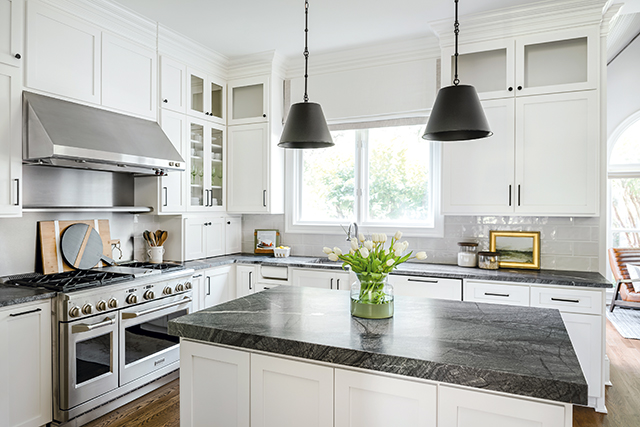
Jena Bula collaborated with Ekren Construction to include white cabinetry as a base that is complemented with dark gray quartzite countertops and a lighter warm gray porcelain tile backsplash for dimension.
Jena Bula, principal designer
Delphinium Design; Charlotte, NC
When discussing white kitchens, Jena Bula’s clients still often ask for white cabinetry.
“They want an aesthetic that is lighter and brighter with an airy feel,” she says. “While there are different ways to achieve that, people often associate it with white.”
However, she has noticed a bit of a shift in what exactly that means and what else is included.
For starters, white doesn’t always mean bright white.
“There are so many different ways to do white,” she says. “It can mean bright white, but it can also mean a warm white or a country white depending on the space, the aesthetic and what other colors are included.”
Plus, clients also seem more open about bringing in other colors.
“There was a time when white kitchens were a lot of
white-on-white-on-white,” she indicates. “But now, they seem to have a little more dimension. People are mixing in different colors and warmer materials. White kitchens aren’t always all white cabinetry, white countertops and white islands.”
Such was the case for a recent kitchen remodel completed in collaboration with Ekren Construction. White shaker cabinets serve as the base, but Bula brought in dark gray quartzite countertops and a lighter warm gray porcelain tile backsplash for added dimension.
“She didn’t want a white-on-white kitchen,” says the designer. “Countertops are an important element in the space. My client needed something durable because she cooks a lot for her family, so the dark quartzite was a great choice for functionality. It also has some texture from its honed and leathered finish, which gives it dimension. It’s a really special element, and in person you can really see that texture.”
Flooring is another way that Bula freshens up today’s white kitchens. Often, she chooses to use warmer toned hardwood for balance. Lighting and plumbing fixtures as well as hardware can also add diversity.
“We used dark hardware in this kitchen, which gives it great balance so everything isn’t all light and bright,” she says. “Fixtures, such as a really cool faucet or fun pendants, and hardware are also a great way to add personality.”
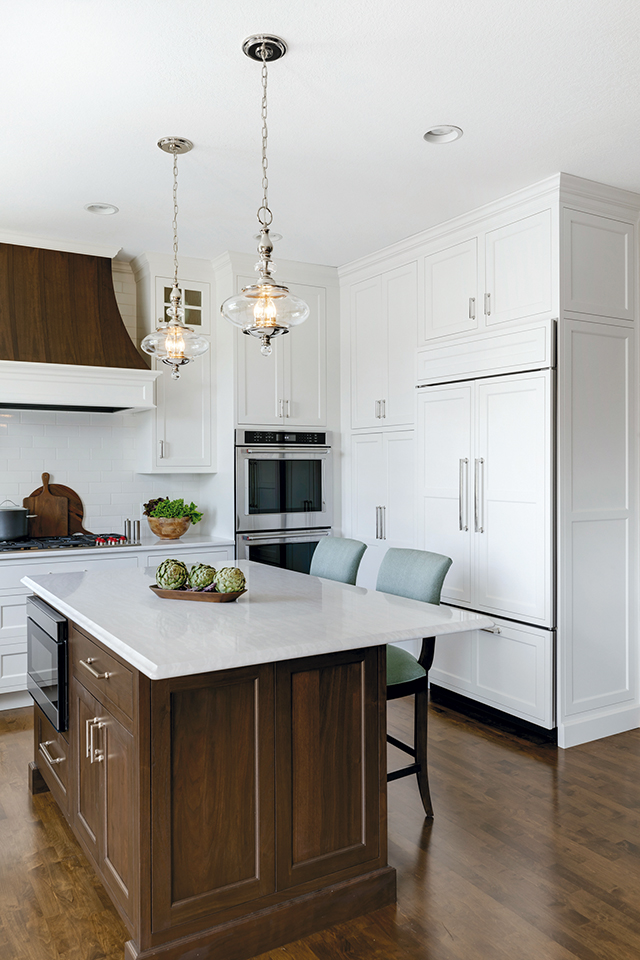
Crystal Kitchen and Bath Design Build – 2506 Tournament Players Cir S, Blaine, MN 55449
Mary Maney, CKBD, ASID, CLIPP
Crystal Kitchens + Bath; Crystal, MN
As a designer with a remodeling company, Mary Maney sees a lot of outdated kitchens, especially those from the 1980s with their distinctive abundance of oak…including oak cabinetry, oak flooring and oak trim.
“People want to tone that down so everything isn’t the same,” she says. “They also want to get rid of the busyness of oak, which, in those dated kitchens, usually has a lot of grain. Often, they do that by keeping the oak floor, and sometimes the oak trim, but they replace the oak cabinetry with white cabinetry. White doesn’t necessarily designate a decade or date a kitchen as much as wood like oak, maple or cherry. White is also popular because it allows everything else – such as a countertop, backsplash, flooring and island – to stand out.”
White inset cabinetry serves as the ‘quiet’ backdrop for one recent kitchen remodel where Maney’s client wanted a ‘statement’ ventilation hood that would serve as the focal point for the room. Reconfiguring the space, the designer eliminated an awkward, angled walk-in pantry to pave the way for the inclusion of a walnut hood that echoes the tones of the dark floor and island base cabinetry. She also tied the kitchen into the adjacent living room by replacing the existing maple bookcases that flank the fireplace with walnut bookcases.
“My client had redone the maple floor a few years previous with a dark stain,” she indicates. “She didn’t want an all-white kitchen, so it seemed logical to include other dark elements. We chose walnut because it allows some grain to show through, which provides texture and isn’t quite as harsh as black. Walnut also gives the kitchen an ‘upscale’ look that she wanted.”
A quartz countertop with a subtle gray veining pattern with ‘movement’ and a backsplash that features a light crackle finish reinforce the white theme while offering variety.
“You don’t want elements of the same color to all have the same tone,” she says. “When that happens, there’s nothing to define the different planes. It’s important to have some contrast.”
Adding paned glass doors to select perimeter wall cabinets also adds interest and makes this space feel special.
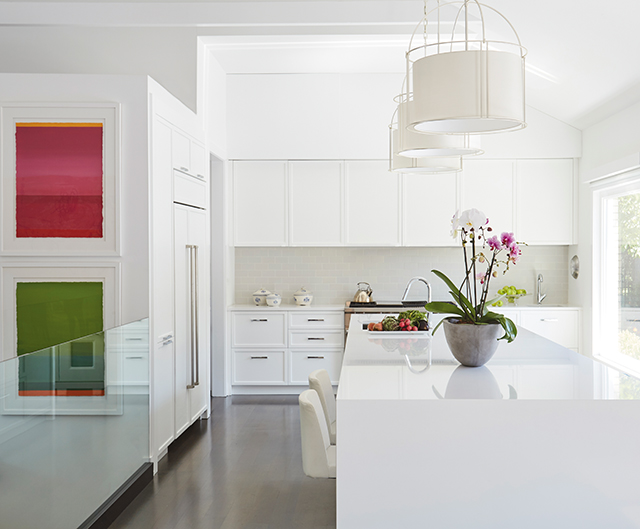
In this kitchen Scott Dresner celebrates timelessness and diversity by combining white perimeter cabinetry, white paneled refrigerator and white quartz countertops with gray cerused oak island cabinetry ‘framed’ in a waterfall of white quartz.
Photos: Jim Tschetter
Scott Dresner
Dresner Design; Chicago, IL
Scott Dresner credits, in part, his love of white kitchens to growing up in a modern home with a white kitchen in Detroit, MI. Now, he incorporates that love of white into his kitchen design business.
“I’m pro-white kitchens,” he stresses. “The white kitchen – and stainless – is my favorite. White kitchens definitely are not dead.”
Part of that affection is due to its classic design appeal.
“A white kitchen will stand the test of time,” he says. “There are still mill shops making the same [cabinet] door they made in the ‘80s. A white kitchen is like Jackie Onassis and Marilyn Monroe…beautiful and timeless.”
Dresner also appreciates the hue’s diversity.
“There’s super modern bright white, warm white, cream white, off white…” he says, referencing a variety of white kitchens posted on his website. Some showcase multiple white elements, including one recent renovation that includes sleek, smooth, bright white back-painted glass cabinetry and a white quartzite countertop with a waterfall edge. Silver trim border details on the cabinets tie them to the countertop’s gray veining pattern, floor and stainless steel appliances. Conversely, another white kitchen features more traditional paneled cabinetry painted in a creamier white, similar to the color of a cameo, which he contrasted with a brighter white coffered ceiling to create separation. Dresner also included a natural stone white/gray veined countertop and matching accent wall and stainless steel appliances.
“I often use stainless steel appliances in white kitchens,” he says. “The combination is like peanut butter and jelly.”
While variations of white with stainless steel dominate some designs, others highlight a mix of materials, including one kitchen that combines white perimeter cabinetry, white paneled refrigerator and white quartz countertops with gray cerused oak island cabinetry ‘framed’ in a waterfall of white quartz. Dark wenge drawer interiors, visible when exposed, provide dramatic contrast.
“It certainly feels like a white kitchen, and everyone considers it a white kitchen,” he says.
This time, the designer blended the cabinetry with the wall color and ceiling beams to create a seamless visual.
“I wanted the cabinetry to essentially go away, to blend into the wall so the huge picture windows ‘speak’,” he says. “There is a lot of white in this kitchen, but it isn’t a sterile space. There are parts of ‘sterileness,’ such as the countertop that is white and shiny. But the rest of the whites have a matte finish so that, overall, there is a Zen, quiet feel to the space. People love this kitchen.”
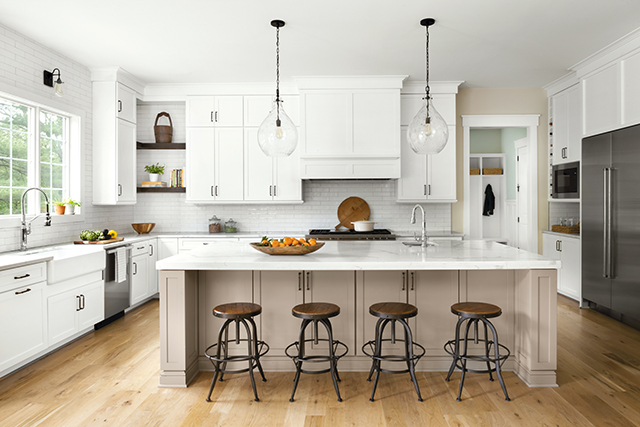
Christina Simon and senior designer Brittany Gunst joined forces in this kitchen to create a modern farmhouse vibe with timeless elements, plenty of storage and an open concept…all with a foundation of white cabinetry, white countertops and a white backsplash. The reclaimed wood shelves serve as a statement piece and the taupe/gray painted island complements the veining pattern in the countertops.
Photo/Styling: Stylish Productions; Charlotte Safavi and Robert Radifera
Christina Simon, CKBD, ASID, president
c|s Design Studio; Clifton, VA
Christina Simon works in a relatively traditional part of the country – the Washington DC suburbs – where she often fields requests for white kitchens.
“People here simply love them, and we’re happy to oblige,” she says. “White is timeless, clean and bright…all things people want for their kitchens. White is also neutral and plays well with others, making it easy to coordinate with appliances and hardwood floors, which is a big element for us.”
These days, the white kitchens she designs often include updates via natural and rustic elements as a complement.
“We introduce texture and contrast into the space to make it more interesting,” she explains.
As an example, she and senior designer Brittany Gunst recently joined forces on a remodel where the clients wanted their new kitchen to have a modern farmhouse vibe with timeless elements, plenty of storage and an open concept…all with a foundation of white cabinetry, white countertops and a white backsplash, as well as a white farmhouse sink, which is another popular choice for her clients.
“When there is a lot of white, it’s important to bring in some statement pieces,” she notes. “In the case of this kitchen, the statement piece is some reclaimed wood corner shelves.”
Additionally, Simon indicates that black accents can add contrast, so she brought in black cabinetry hardware and lighting. In another recent remodel, she made a striking statement with a black ventilation hood.
To provide differentiation amongst white elements, Simon utilizes a variety of sheens throughout a space, such as in this kitchen where the matte finish of the cabinetry plays against the glossy sheen of the elongated 3″x12″ subway tile backsplash.
“This client wanted a simple subway tile backsplash,” she reports, “but its glossy sheen sets it apart from the other white elements. We also like to use handmade tile, which can have different glazing or it may be a slightly different white, such as an off white. We’re seeing a lot of people using a variety of different whites in their kitchens.”
When using white as a countertop, Simon likes to include materials with some veining, such as a marble or marble-look quartz.
“Instead of plain white, we like to use something with a light veining pattern against a white background, because those veins allow us to pull in other colors,” she explains, citing the marble-look quartz in this kitchen that gave them the opportunity to incorporate a taupe/gray painted island.
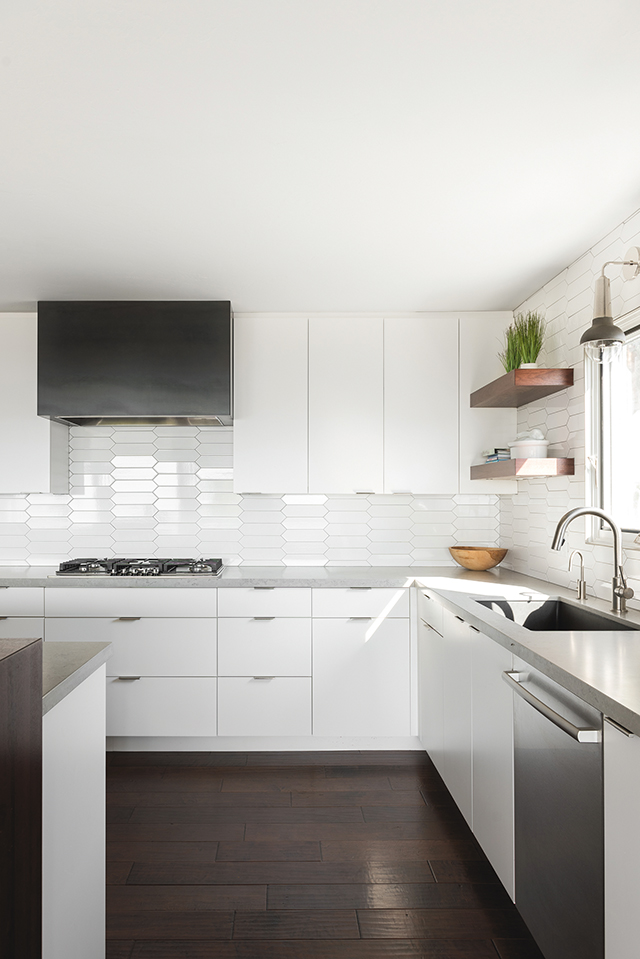
In this remodel, Nicole Zeigler contrasted the white cabinetry and white backsplash tile with a custom edge-grain walnut bar top on the island and walnut floating shelves that coordinate with floor, as well as a custom hot-rolled steel ventilation hood.
Photo: Lucy Call
Nicole Zeigler, NCIDQ
enzy design; Salt Lake City, UT
With a trend towards design that integrates a furniture-style appeal, Nicole Zeigler sees many of her white kitchens offering an assortment of materials beyond just white.
“White kitchens are definitely still popular,” she says. “They never go out of style. They have always been around, and they will continue to be around. But I am seeing more mixed materials rather than straight white. I think that’s because, overall, there’s a trend in kitchen design that incorporates furniture-look pieces, rather than all of the same cabinets. For example, you might see an island with a wood finish and a furniture-style base, or something unique.”
Zeigler sees that updated look as offering a way to add personality and warmth to the space. In particular, wood – or even wood-look vinyl – floors are popular. The designer also adds personality via ventilation hoods or accent cabinets and hardware, which she dubs as the ‘jewelry.’ She also indicates there is still a trend for open floating shelves in a material or finish that offers a contrast to white.
Several of those elements were included in a recent renovation, where gloss white wall cabinets are combined with natural rift-cut oak base cabinets. The hood and the cabinets around it feature a charcoal finish.
“It’s stunning,” she says. “I feel like it’s still a white kitchen, but it’s not an in-your-face-white kitchen because of the other elements we’ve added to it.”
In another kitchen, where she collaborated with cabinet maker/installer Paramount Cabinet and builder Spiro Brothers Construction, wall and base cabinets are white, as is the island cabinetry and the backsplash, which is comprised of elongated hexagon-shaped subway tile. The tile’s glossy finish adds reflectivity while its geometric shape adds interest, without making it busy. However, to mix it up, she included a custom edge-grain walnut bar top on the island that coordinates with the floor and a few floating shelves that frame the window to make it feel more open.
“The wood bar top and shelves bring natural elements into the room and add some contrast,” she says. “They also bring up some of the darkness from the floor to create more balance, without overwhelming the light space.”
Another ‘dark’ element is the custom hot-rolled ventilation hood.
“It’s a really simple box shape,” she says. “But it has a beautiful finish that offers natural depth and subtle marbling. It’s gorgeous against the white backdrop.”
Quartz countertops that mimic honed concrete and slightly oversized pendants that offer the feel and look of linen also prevent the white space from being too sterile.
“Having those elements – the backsplash, the shades, the bar top, the ventilation hood and the countertops – are all important to make this white kitchen more inviting and less institutional,” she says, “especially since it has white slab cabinetry.”
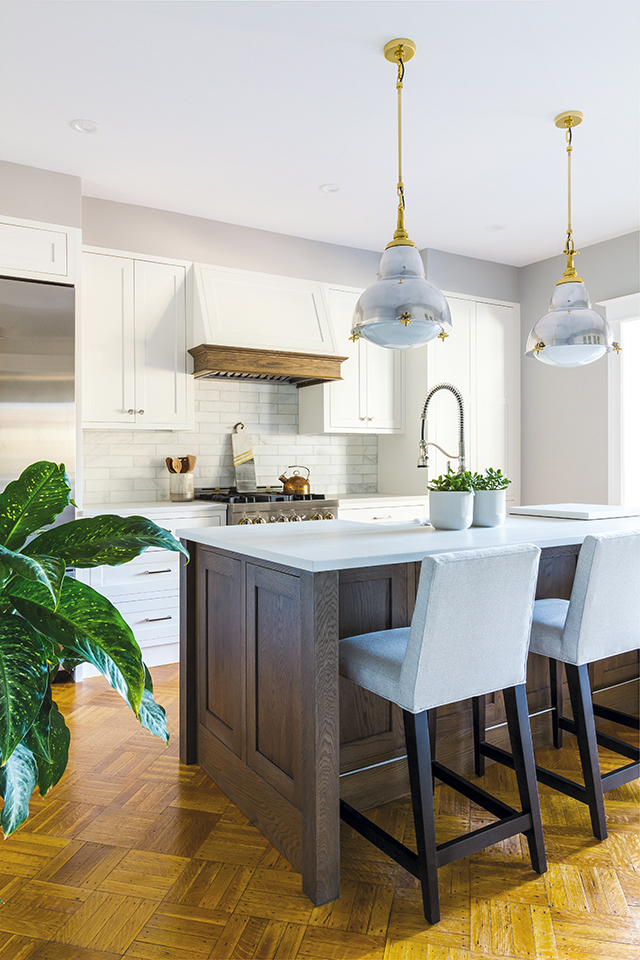
Tamra Pumpelly often uses white cabinetry’s door style and construction to set the tone in a space. In this kitchen, inset cabinetry was appropriate given the historic value of the home. She included a flat-cut white oak island, stained in Driftwood, to add warmth and depth. Incorporating it as an accent on the ventilation hood brings up the eye and ties the perimeter and island together.
Photo: Steve Hershberger
Tamra Pumpelly, operations manager
District Cabinets; Washington DC
Even though Tamra Pumpelly indicates that white kitchens can be a ‘safe’ choice for her clients, that doesn’t mean they can’t be special and beautiful.
“White cabinets can become a backdrop of a kitchen, rather than them being the focal point,” she explains. “Quality cabinetry is expensive, and I think homeowners see it as an investment they want to get right. Elements like hardware and lighting are easier to change out.”
As the foundation, those same white cabinets can also set the tone with their door style and construction.
“An inset or mission door style sets a completely different tone than a slab door,” she says. “The sheen factor also changes a kitchen. A rich matte finish represents a completely different style than a gloss finish.”
As an example, in one recent kitchen remodel, the designer collaborated with Build by Four Brothers to incorporate white inset Elmwood cabinets into their clients’ new kitchen.
“Inset cabinetry was appropriate for this kitchen because of the historic value of the house,” she says. “Clients often are concerned with losing storage with inset, but it immediately elevates a kitchen without looking fussy.”
The team also included a flat-cut white oak island, stained in Driftwood, to add warmth and depth. Incorporating it as an accent on the ventilation hood brings up the eye and ties the perimeter and island together.
The white cabinetry also complements the existing hardwood floor.
“Maintaining the floor was important to the client, so we didn’t want to take away from it,” she says. “The white cabinetry allows the floor to be the focal point and we built the kitchen around it.”
In addition, with a neutral foundation of white cabinetry, Pumpelly sometimes brings color or a wood element to an island to ground it while adding warmth and personality.
“Pops of color can also be used in the lighting, and we love mixing metals and textures in white kitchens,” she adds.
In addition, white cabinetry allows countertops and backsplashes to be the stars of the show in a traditional white kitchen, such as in a recent renovation where white cabinetry and white backsplash tile give the dark gray countertop and gray/white chevron backsplash insert the opportunity to stand out. 
The post Doing White Right appeared first on Kitchen & Bath Design News.
Did you miss our previous article…
https://www.thekawaiikitchen.com/?p=438